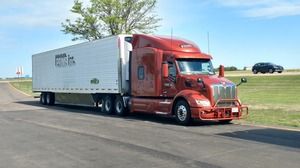Do Trailer Tails Really Work?
Topic 17077 | Page 1

I've wondered this as well. You see some companies using the tails, and some using the trailer blades and some using both.
I think the blades, or skirts are mainly used for stability. I know prime uses the trailer tails a lot. I'm assuming that they have some merit, otherwise they wouldn't spend the money installing them.
Now the one I'm curious about are the wheel covers. I'm wondering if those are also a fuel saving method and how much exactly does something like that save?
I'm going to assume that all of it is a case of, it doesn't save much in the short term, but over the course of a year, it may make a difference.
HOS:
Hours Of Service
HOS refers to the logbook hours of service regulations.Here's what Wikipedia says:
A trailer tail, boat tail, or rear fairing is an aerodynamic device intended to improve the fuel economy of semi-trailer trucks. It comprises a set of panels, usually collapsible, which fold out from the rear of the trailer, creating a tapered shape that reduces drag from the low-pressure wake created behind the trailer. Trailer tails are one form of aerodynamic technology verified by the U.S. Environmental Protection Agency's SmartWay Transport Partnership. Trailer tails alone have demonstrated a fuel savings of 1%–5%, and in concert with trailer skirts, 9% improvement has been demonstrated.
Any time you notice several truck companies doing the same thing (Think auto-shifting transmissions), you know it's saving the company money.
Also from that Wikipedia article: think that aerodynamic addition is the latest in technology? The first T-tail patent was issued in 1898, for railroad cars.
Prime told me the wheel covers save 2%, the wings save up to 15%, and the skirts save 5%. Does it work? Who knows. But they are serious about it enough that when my friend took the wheel covers off for easy access to air tires, the terminal put new ones on.
I don't drive California but my former trainer said all trailer going to Cali now need skirts. The concept is less fuel being used, less emissions for the air.
Terminal:
A facility where trucking companies operate out of, or their "home base" if you will. A lot of major companies have multiple terminals around the country which usually consist of the main office building, a drop lot for trailers, and sometimes a repair shop and wash facilities.

I can certainly tell the difference when I have a trailer without the tail. Does not seem like much percentage wise, but over time it adds up. When I have a trailer without a tail, my fuel mileage for the week goes down. I average 8 - 8.5 MPG or better with a tail, without I struggle to get 8 MPG (and that is with a light load on flat terrain).
Prime has done some wind tunnel experimenting, and if it didn't pay to have the skirts/tails, Robert Low would not be spending the monies to have them installed. This is one time that his maintenance guy (Paul Higgins) actually did get something right. Now if we could just get him to quit turning down the power on the trucks, we would be in much better shape.
Ernie
I've only ever pulled one trailer with a tail. Turns out it was one of a few test trailers from a few years ago. I guess for whatever reason the company decided not to use them. We do have skirts on most of the trailers though.
Prime told me the wheel covers save 2%, the wings save up to 15%, and the skirts save 5%. Does it work? Who knows. But they are serious about it enough that when my friend took the wheel covers off for easy access to air tires, the terminal put new ones on.
I don't drive California but my former trainer said all trailer going to Cali now need skirts. The concept is less fuel being used, less emissions for the air.
22% savings on fuel? Time the hundreds (thousands) of units they operate? You can bet they wouldn't be spending that kind of $$ to equip each tractor and trailer like that - if they weren't going to see substantial savings.
That and the regulatory idiocy of California - drives companies to "early adopt", since California (CARB) telegraphs their moves early and pretty much turns into law, every tree-hugging expensive technology that costs the company $$.
So likely, the larger companies start to implement this stuff earlier, to spread the cost of implementation out - rather than waiting until the day it becomes mandatory, to outfit its entire fleet.
Rick
Terminal:
A facility where trucking companies operate out of, or their "home base" if you will. A lot of major companies have multiple terminals around the country which usually consist of the main office building, a drop lot for trailers, and sometimes a repair shop and wash facilities.
Tonight, Nov. 11, at a truck stop just south of St Louis, I saw a Swift trailer with a trailer tail.
 They're coming!!!
They're coming!!!
New Reply:
New! Check out our help videos for a better understanding of our forum features

















Preview:








 TT On Facebook
TT On Facebook
One new fad I've noticed in the past few months (years?) is trailer trails. Do they really reduce drag and increase fuel efficiency or are they just another passing fad? I don't have any experience with them.